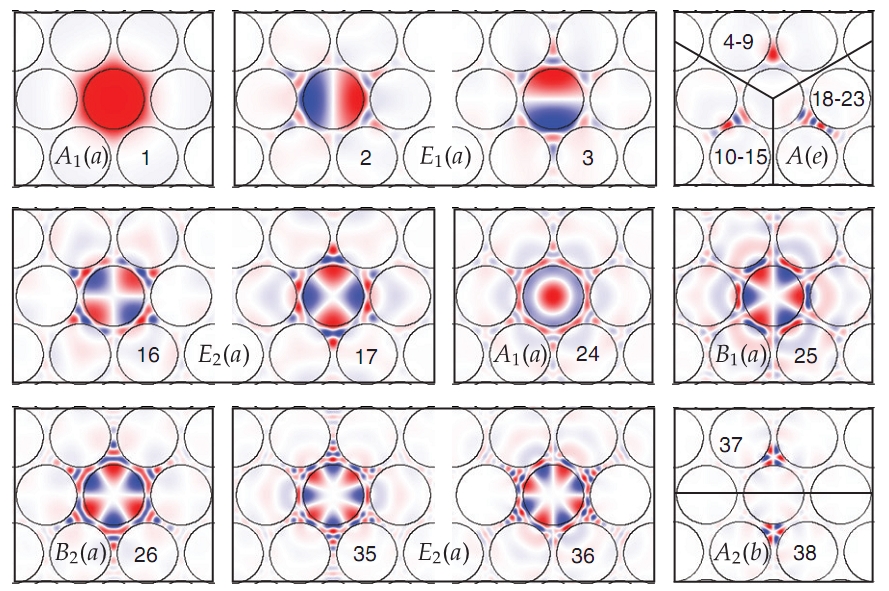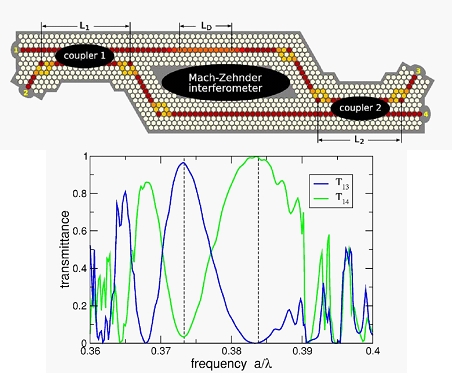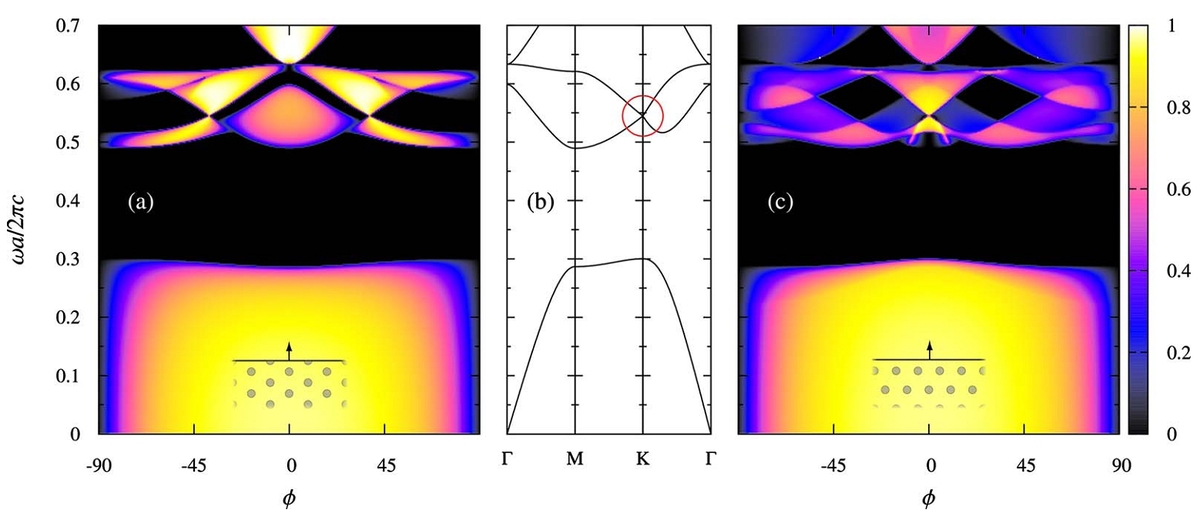A1.1: Theory of Photonic Crystal Structures and Concepts for Photonic Crystal-Based Devices
Subproject Leader: Kurt Busch
Institut für Theoretische Festkörperphysik, KIT
Contributing Scientists:
Present: Sabine Essig, Daniel Hermann, Jens Küchenmeister, Patrick Mack, Sergei Mingaleev, Christian Wolff, Thomas Zebrowski
Photonic Bandstructure
Photonic crystals (PhCs) represent a novel class of optical materials with unique optical properties. In these periodic dielectric structures, Mie-resonances from individual elements and Bragg scattering from the underlying lattice leads to the formation of an energy-bandstructure for electromagnetic waves – the photonic bandstructure. Nano-fabrication technologies provide flexibility in material composition, lattice periodicity, symmetry, and topology and allow one to tailor the photonic bandstructure to (almost) any need. In turn, this facilitates a far-reaching control over light propagation [1].
Photonic Crystals: A Platform for an Integrated Photonics
Perhaps the most dramatic modification relative to ordinary dispersion relations occurs when suitably engineered PhCs exhibit frequency ranges over which the propagation of light is forbidden irrespective of direction. For instance, such photonic band gaps (PBGs) eliminate the problem of light leakage from optical micro-circuits that are embedded in PhCs. Obviously, the realization of such a PhC-based integrated photonics entails two aspects: The fabrication and characterization of large-scale high-quality structures and the development of blueprints for photonic devices and entire circuitry. Regarding the first aspect, we closely collaborate with Martin Wegener’s group (see our joint review [2]). As part of their work in subproject A1.4: Three-Dimensional Photonic Crystals they have developed and optimized a technique called direct laser writing which allows the fabrication of (almost) any structure that one (and we) can come up with.
But how to compute such large and complex structures that easily extend over many wavelengths in all directions? Here, we have exploited the conceptual proximity of PhCs to ordinary (electronic) crystals and have developed an approach based on photonic Wannier functions (see our review [3]). In a nutshell, photonic Wannier functions represent the optical counterpart of localized atomic orbitals and thus provide a convenient basis for a qualitative understanding of PhC-based circuitry (akin to the LCAO-method in molecular systems). In addition, the Wannier function approach facilitates highly efficient and fully quantitative computations that allow design optimizations. Based on this, we have suggested a novel route towards PhC-based circuits via the infiltration of high-index PhC structures with low-index materials such as polymers or liquid crystals (see [4] for a recent experimental realization). Such multi-component systems provide huge flexibility regarding the design of functional elements and depending on the constituent materials they may exhibit strong nonlinear responses and/or may be electro-optically tunable.
Modified Thermal Radiation from Photonic Crystals
Consider an ensemble of emitters that (i) are in thermal equilibrium and (ii) are embedded in a PhC. As the photonic bandstructure provides an electromagnetic environment that is much different from vacuum or homogeneous materials, one expects that thermal emission in PhCs becomes strongly modified. On the one hand, the large density-of-states for frequencies near van-Hove-singularities in the photonic bandstructure leads to an enhanced energy density. On the other hand, these van-Hove singularities are characterized by low group velocities such that the radiation flow near these frequencies is slowed down. To study these competing effects, we have developed an approach [5] that describes the (in general highly-directional) flow of thermal radiation solely in terms of the geometric details of the bandstructure. Indeed, we find that it is the area of the isofrequency contour that determines the enhancement of thermal radiation within an ideal PhC. In the presence of interfaces, our “microscopic” approach recovers Kirchhoff’s law and yields the relevant physical quantities such as the directional spectral emissivity [6]. Besides allowing for an efficient design of optimized PhC-structures, our approach provides a basis for the study of non-equilibrium processes.
References
| [1] | K. Busch, G. von Freymann, S. Linden, S. Mingaleev, L. Tkeshelashvili, and M. Wegener, Periodic Nanostructures for Photonics, Phys. Rep. 444, 101 (2007) |
| [2] | G. von Freymann, A. Ledermann, M. Thiel, I. Staude, S. Essig, K. Busch, and M. Wegener, Three-Dimensional Nanostructures for Photonics, Adv. Funct. Mater. 20, 1038 (2010) |
| [3] | K. Busch, C. Blum, A. M. Graham, D. Hermann, M. Köhl, P. Mack, and C. Wolff, The Photonic Wannier Function Approach to Photonic Crystal Simulations: Status and Perspectives, J. Mod. Opt. 58, 365 (2011) |
| [4] | P. W. Nolte, D. Pergande, S. L. Schweizer, M. Geuss, R. Salzer, B. T. Makowski, M. Steinhart, P. Mack, D. Hermann, K. Busch, C. Weder, and R. B. Wehrspohn, Photonic Crystal Devices with Multiple Dyes by Consecutive Local Infiltration of Single Pores, Advanced Materials 22, 4731 (2010) |
| [5] | M. Florescu, K. Busch, and J. Dowling, Thermal Radiation in Photonic Crystals, Phys. Rev. B 75, 201101(R) (2007) |
| [6] | C. Schuler, C. Wolff, K. Busch, and M. Florescu, Thermal Emission from Finite Photonic Crystals, Appl. Phys. Lett. 95, 241103 (2009) |
List of Publications 2006-2011 as PDF
Subproject Report 2006-2010 as PDF


